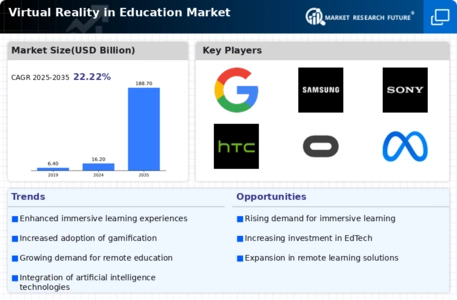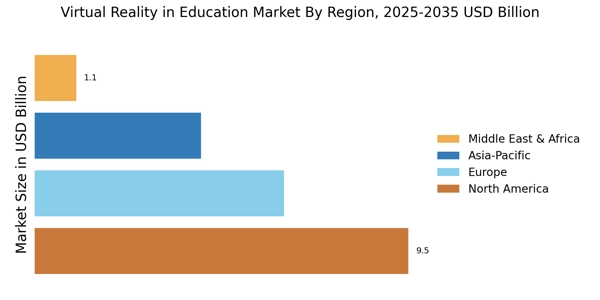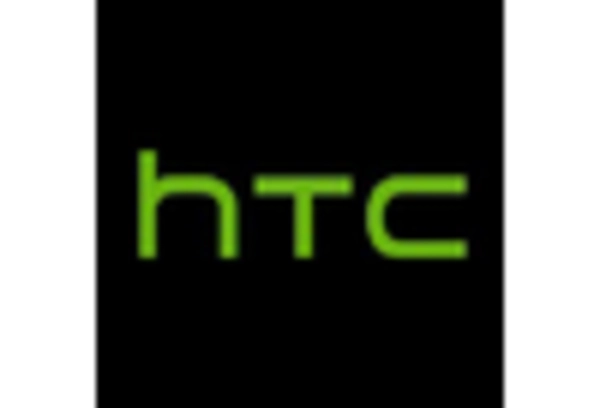Technological Advancements
Technological advancements play a crucial role in propelling the Virtual Reality in Education Market forward. The rapid evolution of VR hardware and software has made immersive learning more accessible and affordable for educational institutions. Innovations such as lightweight headsets, improved graphics, and user-friendly interfaces have lowered barriers to entry, enabling schools and universities to integrate VR into their curricula. According to recent data, the VR hardware market is projected to grow at a compound annual growth rate of 30% over the next five years. This growth indicates a robust interest in VR technologies, which could lead to more educational applications being developed. As technology continues to advance, the potential for creating more engaging and effective learning experiences within the Virtual Reality in Education Market expands significantly.
Enhanced Engagement and Retention
The Virtual Reality in Education Market appears to be driven by the enhanced engagement and retention rates associated with immersive learning experiences. Studies indicate that students exposed to VR environments demonstrate a 75% retention rate compared to traditional methods, which hover around 10%. This stark contrast suggests that VR can transform mundane subjects into captivating experiences, thereby fostering deeper understanding. As educational institutions increasingly recognize the potential of VR to captivate students' attention, the demand for VR solutions is likely to surge. Furthermore, the ability to simulate real-world scenarios in a controlled environment enhances experiential learning, making complex concepts more accessible. Consequently, this driver is pivotal in shaping the trajectory of the Virtual Reality in Education Market.
Increased Focus on STEM Education
The increasing emphasis on STEM (Science, Technology, Engineering, and Mathematics) education is a significant driver for the Virtual Reality in Education Market. Educational institutions are actively seeking innovative methods to enhance STEM learning, and VR offers unique opportunities to visualize complex scientific concepts and engineering principles. For instance, VR can simulate laboratory experiments or engineering challenges, providing students with hands-on experience without the associated risks. Reports suggest that the integration of VR in STEM education can improve problem-solving skills and critical thinking. As governments and educational bodies prioritize STEM initiatives, the demand for VR solutions tailored to these subjects is likely to rise, further propelling the growth of the Virtual Reality in Education Market.
Personalized Learning Experiences
Personalized learning experiences are becoming increasingly vital in the Virtual Reality in Education Market. The ability to tailor educational content to meet individual student needs enhances learning outcomes and engagement. VR technology allows educators to create customized learning paths, enabling students to progress at their own pace. This adaptability is particularly beneficial for diverse classrooms where students have varying learning styles and abilities. Data indicates that personalized learning can lead to a 30% increase in student performance. As educational institutions strive to accommodate different learning preferences, the demand for VR solutions that facilitate personalized education is expected to grow. This trend underscores the potential of the Virtual Reality in Education Market to revolutionize traditional teaching methodologies.
Global Collaboration and Connectivity
The rise of The Virtual Reality in Education Industry. As educational institutions increasingly seek to connect students across geographical boundaries, VR provides a platform for collaborative learning experiences. Virtual classrooms can bring together students from different parts of the world, fostering cultural exchange and collaborative projects. This interconnectedness not only enriches the learning experience but also prepares students for a globalized workforce. Recent studies suggest that collaborative VR learning can enhance teamwork and communication skills, which are essential in today's job market. As the demand for collaborative educational tools grows, the Virtual Reality in Education Market is likely to expand, offering innovative solutions that facilitate global learning.


















Leave a Comment